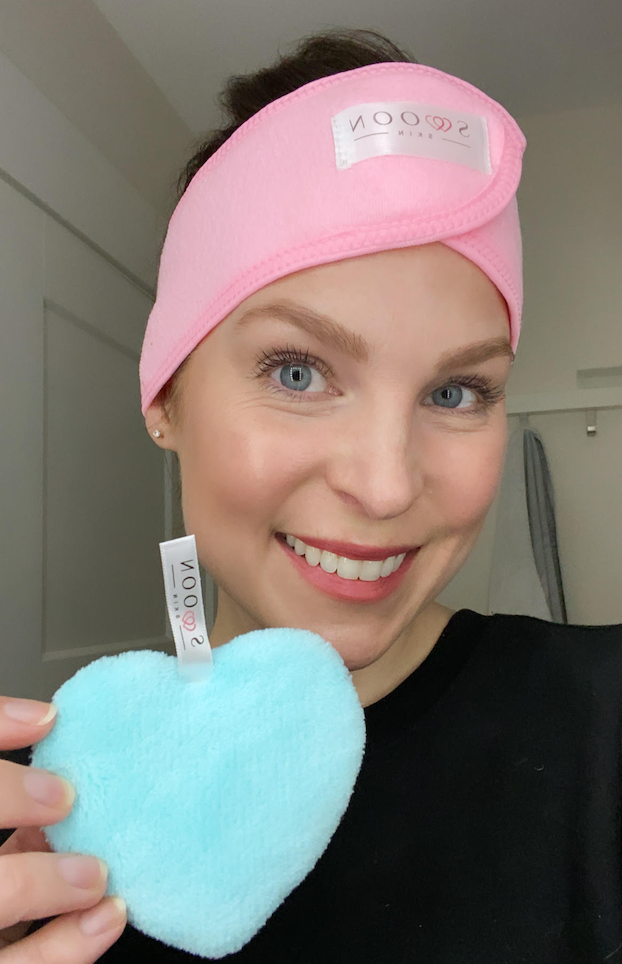Hello everyone! Baby, it’s cold outside and this is the time of year when we need (and deserve) a revamp of our skin routine. So below you’ll find all of my top winter skincare tips and favourite products to carry you through this dry, cold season.
But first, a little about me as it’s been a minute since I introduced myself. My name is Megan, you will find me as @immfab on social media. I was a professional make-up artist with my own bridal and stock photography company in Calgary before moving to Amsterdam where I transitioned my passion for beauty to writing when I landed in Toronto.
For the past ten years I’ve been the Beauty Editor for immrfabulous.com and I’ve appeared on a few seasons of The Marilyn Denis Show as a Beauty Expert.

I love all things skincare and makeup and still remember the days when all the choice we had was CoverGirl or Maybelline – so living in a time where skincare has become such a passion for so many is truly exciting and keeps me motivated to keep learning in this space. It’s nice to (re) meet you – now, let’s begin!
Your first question might already be – do we need special winter skincare routines?
The answer is – ‘most likely’, so I’ll give you some tips and product recommendations to combat dry, dull skin – keeping that skin looking dewy and glowy, year-round. We’ll talk occlusives, acids, exfoliators, niacinamide, and lip care. Strap in, grab a snack and let’s get rolling!
First up – Occlusives. The wonder ingredient.
In the winter the biggest skin concern is dryness. This can be combated externally with a humidifier and drinking plenty of water, but quick wins for the face include using products that act like an occlusive – locking in moisture.
Now – what is an occlusive?
Occlusives are moisturizing agents that work by forming a protective layer on the surface of your skin – creating a barrier to prevent moisture loss. They are mainly lipid (oil) based, meaning they can leave a slightly greasy sheen to the skin. They don’t increase moisture levels but prevent moisture loss.
Occlusive moisturizers fill the cracks in dry skin and make a film that prevents water loss. Their trademark is the fact that they essentially physically block water loss — think petroleum jelly-based products like Vaseline, Lanolin, and Aquaphor.

You might be thinking – this sounds gross, I am not using Vaseline on my face.
Well, I recommend if you have dry, tight, or cracked skin – that is exactly what you do. Applying your regular moisturizer, then locking it in physically with an occlusive will create soft, smooth and hydrated skin. You may have heard the term ‘slugging‘ before…well, that is all slugging is :).
Hot tip – if you use Vaseline on your face at night, change your pillowcase much more frequently than you normally do or you might start to experience breakouts. But – occlusives don’t cause breakouts, or clogged pores which you might think they would due to their ‘greasy’ consistency. So, if you are acne prone – you can still use an occlusive if you wish.
Next winter skincare tip – SPF
SPF is the key step in any skincare routine, as I’ve said before if you don’t use SPF daily, you may as well throw every other product out because you’re wasting your money. Applying SPF in the winter is something a lot of people skip – shorter daylight hours, less time outside, more cloudy days…but those are lazy fallacies we tell ourselves to skip that one step.
Don’t skip the step!
While there are less direct UV rays in the winter, there is significant reflection of these rays which can still easily cause sunburn. Even if you don’t get burned, the UV rays are still at work causing wrinkles and aging the skin.
Fact – UV rays can penetrate winter clouds.
And, if you participate in winter sports, they put you at higher risk of UV exposure UV radiation increases by 5 percent with every thousand feet you rise above sea level. This means the higher your elevation, the greater your exposure to harmful UV rays.
Fact – most people don’t realize that winter’s harsh conditions erode your sunscreen even faster than sweating it off in the summer months. The Skin Cancer Foundation cautions that snow and strong winds wear away sunscreen and reduce its effectiveness, so during winter, you can’t just apply in the morning and assume you’re protected all day. Instead, it’s recommended that during winter you re-apply every two hours.
My favourite SPFs these days for my sensitive are:
Now let’s talk about your winter skin and exfoliation
Skin cells typically regenerate every month or so. But things like sun exposure and aging can slow this process down.
That’s where exfoliation comes in handy – it’s a quick way of removing dead skin, and it can do everything from brightening your complexion to fading acne scars.
I want to talk to you about acid-based exfoliation as I am pretty sure everyone knows about physical exfoliation. Quick tip – if you like physical exfoliation – do not use products with natural grit – crushed shells, etc. Anything rough and not perfectly smooth will cause micro-tears on your skin. Stay clear of St.Ives apricot scrub at all costs.
OK – so acid-based exfoliators – specifically – AHAs and BHAs
What are Alpha hydroxy acids (AHAs)?
AHAs include the likes of glycolic, lactic, citric, and malic acid. They tend to come from fruits, but can also be produced synthetically. With the ability to dissolve in water, they work on the surface of the skin to improve its texture.
When it comes to AHAs, such as glycolic and lactic acids, it’s crucial not to use too much, too soon. “Once every other day is plenty.” When looking for products, try to find skincare with a concentration of 5-10% for high effectiveness.
Here are some of my favourite products containing AHAs:
Now – I love glycolic acid. Another wonder ingredient.
Glycolic acid is an AHA with the smallest molecular structure, which allows it to penetrate the skin for deeper exfoliation. Glycolic acid is used to improve the skin’s appearance and texture through exfoliation while reducing fine lines, hyperpigmentation, dark spots and uneven skin tone it is also said to boost natural collagen and elastin production. It’s also great to add into your winter skincare routine because it boosts your skin’s natural hyaluronic acid production and improves overall skin hydration. A great glycolic on the market is from SkinCeuticals:

As a rule of thumb, on the days you choose to include AHAs in your routine, avoid products containing Vitamin C and retinol immediately after, allowing your skin to work with a single active ingredient at a time, therefore reducing the risk of over-stimulation causing adverse reactions. It’s also important not to mix your AHAs, as this can cause immediate irritation and very unhappy skin.
What are Beta hydroxy acids (BHAs)?
These deeper-working acids not only benefit skin texture, but also unclog pores and remove acne-causing sebum. Examples of BHAs include salicylic acid and tropic acid. Unlike AHAs, it is safe to use a BHA daily.
BHAs are oil-soluble, so they can penetrate your pores, as well as work on the skin’s surface. BHAs can soothe and calm skin, making them ideal for sensitive skin types or people who experience redness.
How do you know which type of acid to use?
AHAs are often used to improve skin tone and mild areas of discoloration.
BHAs, on the other hand, are ideal for oily or acne-prone skin due to their pore-unclogging properties.
Another key winter skincare ingredient I want to talk to you about is Niacinamide.
What is niacinamide? It’s a form of Vitamin B3 that has a lot of skin benefits like anti-oxidant effects (free radicals that can scavenge the skin ultimately aging the skin) it can also improve the skin barrier and moisture retention – warding off dryness and irritation especially when it gets colder and the humidity drops.
It is also great to calm down redness by improving skin barrier function – so maybe mask irritation, wind burn, rosacea or post acne redness. It can also help in hyper pigmentation. If you suffer from rosacea – products with licorice root are also great, and often products with that ingredient are lighter-weight and tend to work well for rosacea.
There is no shortage of products with niacinamide on the market. Now there is no need to go out and buy a pure niacinamide serum, these can actually cause irritation, it’s better to find products with this ingredient in them, in lower percentages – 2-5% is ideal. The best way to incorporate this ingredient is to find a moisturizer with niacinamide in it.
A great produce is the CeraVe skin renewing night cream. This is a shea-butter based cream that is nice and thick – it is perfect for dry and mature skin, but regardless of skin type – this is great for nighttime wear as this reduces trans-epidermal waterloss. And a new CeraVe product is their itch relief, which arrived in stores in March 2021 and is great for reducing redness and itch.
Finally – Winter Lip Care Tips
Winter Raisin Lips are not hot.
Think of the skin on your lips like naked face skin.
It is super sensitive, and it doesn’t produce sebum – so help a pair out, right?
I know my lips in the winter are often a peely nightmare unless I use a super hydrating balm and occlusive.
First – you need to prep your lips, if you are applying balm overtop dry, cracked skin – it won’t work. You need to exfoliate your lips, just like you do with your face.
One tip I learned was something called ‘Lip Basting’ and boy, does this work! First you apply a glycolic acid to your lips, letting it sink in while you do your make-up, then apply a very thick layer of moisturizer over top – like the Weleda Skin Food, or something as thick as that. Let that sink in. Then, embrace the natural peel that will happen. Its satisfying and kind of marvellous. Make sure you wear SPF on your lips if you do this technique during the day – I recommend doing this once per week as part of your nighttime routine.
You can also use a physical lip exfoliator – I don’t like those exfoliators with big chunks of physical exfoliants – I don’t think they are effective and they’re really messy. Look for something finer milled.
Once your lips are exfoliated – use a thick lip balm, not a gloss and definitely not a plumping product as those irritate and dry the skin.
I really like the La Mer lip balm, the Jack Blacks (as this has SPF 25 in it), and the wet n wild lavender sleeping mask (my fave).

Try to wear SPF on your lips, and if you are extra dry – at night apply your balm, then lock it in with an occlusive like Vaseline. And that’s it, team – a few key tips and products to keep your winter skin fresh and dewy.
OK, thanks for reaching the bottom of the read if you have!
For more tips, tricks, first looks and general beauty info – please follow me on IG as @immfab.
MFab
Other posts you might like to peep:
















Excited to try the lip blasting! My lips feel permanently chapped or peeling!